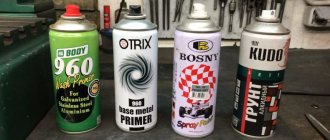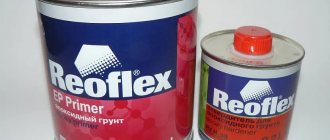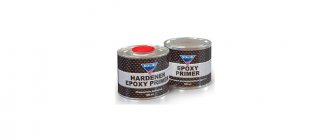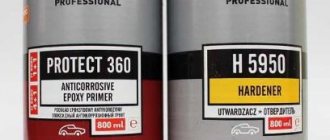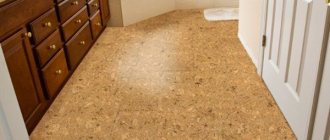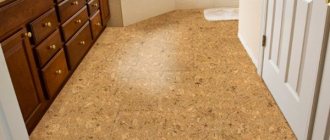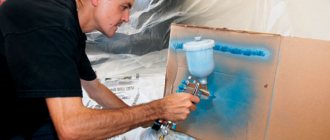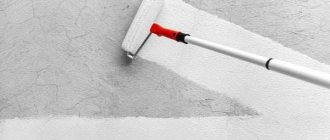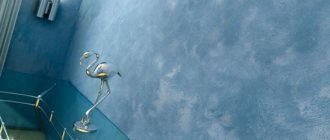What it is?
You should understand what acid soil is, then the principles and main tasks of using the substance will become obvious. Acid primer is a primer, sold in a can or as a liquid, consisting of phosphoric acid, sometimes with the addition of zinc, and is used to ensure better adhesion, valued for its anti-corrosion characteristics. The material is used for initial processing of car bodies.
Can only be used as a first coat; paints and varnishes cannot be applied over the acid primer layer. Protection against corrosion occurs due to the chemical properties of the product, unlike other primers with a mechanical protection principle.
A layer of such a composition cannot be treated with an epoxy composition, since the properties of the second layer neutralize the acidity.
To combat rust, acid primer is a powerful tool because it can completely destroy it.
The material has many useful properties that go beyond its anti-corrosion effect:
- thermal stability. High temperature does not have a negative effect on the substance;
- moisture resistance. The primer does not react under the influence of moisture and salt. The listed actions are especially important in winter, when there are a lot of salty mixtures and high humidity;
- protection from aggressive environments. The acid coating does not react in any way to numerous chemical compounds: oils, gasoline, etc.;
- weather resistance. The external conditions and operating environment for the machine are not terrible even without additional paint coating.
Acid primer for cars: ranking of the best
Despite the abundance of primers on sale, there are not many “working” products among them. If you need a “working” acid primer for rusty metal for a car, we suggest using the ratings we have compiled.
Acid adhesion primer MonoWash
| Characteristics | |
| Container volume, ml | 400 |
| Waiting time between layers, min. | 10-15 |
| Compatible with professional primers, putties, enamels | The composition is allowed to be used with all known auto chemicals |
| What materials can it be applied to? | Well compatible with steel, galvanized surfaces, plastic |
| Working temperature | Not less than 17 °C |
| Peculiarities | The manufacturer claims that the shape of the spray nozzle chosen by him ideally reproduces the “torch” of professional spray guns |
This acid primer for car repairs in cans (reviews confirm this) can be successfully used in all cases of restoring the integrity of the body, when it is necessary to prevent the spread of corrosion. It is recommended to use the product before applying sealant to the joints of body parts.
Based on the totality of its working properties, we can recognize this particular product as the best - it combines reasonable cost, versatility and excellent uniformity of application.
Acid primer spray 1K, to protect painted metal 400ml Jeta Pro 5558 beige
| Characteristics | |
| Container volume, ml | 400 |
| Waiting time between layers, min. | At least 15 |
| Compatible with professional primers, putties, enamels | Good, except for polyester based products |
| What materials can it be applied to? | Putty |
| Working temperature | Minimum 20-21 °C |
| Peculiarities | The material dries quickly, no sanding required |
Inexpensive and high-quality composition that protects the metal well from further spread of rust.
Aerosol primer Body 965 WASH PRIMER acidic 1K (clear) (0.4 l)
| Characteristics | |
| Container volume, ml | 400 |
| Waiting time between applying layers, min | 15 |
| Compatible with professional primers, putties, enamels | High |
| What materials can it be applied to? | All metal surfaces |
| Working temperature | Optimal – 19-22 °C |
| Peculiarities | The primer is transparent, which is why it does not change the color of the substrate in any way, simplifying the selection of the final color |
Another high-quality reactive primer for cars, characterized by ease of use and quick “setting”.
Priming the car body
After application it reacts quickly and dries. A layer of acrylic can be applied in just half an hour after the composition has completely dried, which greatly saves time spent on body repairs.
Acid primer Reoflex Washprimer for sanding aerosol
| Characteristics | |
| Container volume, ml | 520 |
| Waiting time between layers, min. | At least 25 minutes |
| Compatible with professional primers, putties, enamels | Good with all except polyester based compounds |
| What materials can it be applied to? | Aluminium, galvanized and stainless steel, ferrous metal |
| Working temperature | 18-23 °C |
| Peculiarities | Excellent anti-corrosion protection, good adhesion of the applied paint coating |
Cheap and inexpensive, this acid-based reactive composition allows you to qualitatively phosphate the surface being treated, protecting the metal from the process of chemical corrosion.
Acid phosphating primer Novol Protect 340 with hardener
| Characteristics | |
| Container volume, ml | 200 – main composition, another 200 – hardener of the working mixture in a separate bottle |
| Waiting time between layers, min. | At least 15-25 |
| Compatible with professional primers, putties, enamels | High, excluding putties |
| What materials can it be applied to? | Steel, metal, plastics |
| Working temperature | 20-22 °C |
| Peculiarities | Do not putty (the material itself can act as putty). The composition provides excellent adhesion of paint and varnish coatings. The best effect is achieved when used in conjunction with acrylic-based primers |
This acid primer for cars is characterized by fast curing, excellent resistance to corrosion, and compatibility with most types of materials used by car manufacturers. The working composition is prepared by mixing the two components immediately before use.
Acid etching primer ACID
| Characteristics | |
| Container volume, ml | 450 (available in a liter tin) |
| Waiting time between layers, min. | At least 20 |
| Compatible with professional primers, putties, enamels | Compatible with all professional types of automotive chemicals |
| What materials can it be applied to? | Steel, aluminum, plastics, remnants of old paintwork, polyester putty and fiberglass |
| Working temperature | 20-23 °C |
| Peculiarities | The composition is compatible with polyester-based materials |
This acid primer for cars, the use of which is justified during all types of body repairs, protects the metal of the body from corrosion processes. The material is recommended for use in the most critical areas.
The manufacturer allows the application of a new paint coating directly onto the dried phosphate primer - this composition compares favorably with the products described above.
But to get the best effect, the company itself recommends completely cleaning off the remnants of the old paintwork. In this case, the surface will be as smooth as possible, without potholes, drops and “craters”.
What is the peculiarity of the composition
Acid primer for cars is a strong substance that ensures sufficient resistance of the frame to moisture and helps destroy rust. To completely remove rust before applying paint, it is recommended not to skimp on primer and buy a product from trusted brands.
The acid primer is based on phosphoric acid and a zinc additive. The product is applied exclusively as the first layer, that is, sprayed directly onto the metal. Before use, the surface must be degreased, this will help remove particles of rust and grease. Drying time at room temperature (20 °C) is 15 minutes.
When the composition has completely set, you need to additionally walk over the area with an acrylic primer. It helps to even out the layer. It is better to apply the composition to the seams with a brush. If you need to treat large areas, you should choose a spray bottle.
Acid primer is a mixture of phosphoric acid and zinc, it is primary and is sprayed directly onto the bare metal
Important! Do not apply the composition to old putty or poorly cleaned metal, otherwise the subsequent coating will peel off over time. Acid primer is applied only to clean, degreased metal; if there are old coating particles, you can use acidic epoxy primer.
In each case, the substance requires subsequent coating with a 2-component primer and filler. When high-quality preparation has been completed, you can begin coating with an additional layer of primer, putty and paint.
You cannot apply other compounds directly to the acid coating, the only exception being an insulating primer. Etching is a critical vehicle prep and treatment procedure to ensure metal integrity and corrosion protection. Welding seams are always coated with the substance.
Description and types of wash primers
The main component of the reactive primer is phosphoric acid, which forms a poorly soluble film on the surface that is firmly bonded to the metal of the car.
Characteristics of acid soil:
- resistance to moisture and salt;
- wear resistance;
- the acidic aggressive composition is able to penetrate the metal and thus increase adhesion;
- high resistance to chemicals.
Acid primer for car repairs is divided into two types:
- Primary one-component - it does not require the addition of an activator or catalyst (not to be confused with a diluent!). An example of such a primer is Mobihel Primer 1K.
- Primary two-component - here you need to add a hardener, which in acidic primer for cars is phosphoric acid. When mixed, it interacts with pigments, artificial resins and other components, generating heat. Examples of two-component reactive primers are Novol Protect 340 Wash Primer, Body 960.
Types of acid soils for cars
There are 4 main groups based on composition:
- with one component. The composition is immediately ready for use, there is no need for preparation or preparation. Most often sold in a can for simple application of acid primer, but can be adapted for spray coating in 1 thin layer. When the material acquires the proper qualities, it is treated on top with acrylic with hardener additives;
- 2-component. Before use, you must prepare the substance; to do this, just mix it with the activator. The consistency of the product can be hard or soft. Professionals prefer hard options, as they result in a more durable film over the entire surface. Can be applied in 1, 2 or 3 layers, it is worth considering the recommendations of the product manufacturer. Between each application you need to maintain an interval of about 5 minutes in warm rooms;
One-component primer is ready to use - it does not require preliminary preparation
- reactive form. It is used to process pure metal coating; it forms a tiny layer (from 8 to 13 microns). The top also needs acrylic coating. It is the basis; the necessary layers are then applied to it;
- Self-Etch primer. Refers to the ingredients that make up the soil; it means a composition with the addition of zinc. Used to eliminate irregularities and improve the quality of grip. Initially, the acidic substance acts on the metal, causing a protective coating of frozen polymer products to appear.
Principles of use, maximum layer thickness and mixing methods are described for each product separately and may vary significantly.
Application
Etching primer is a primary primer. It is applied only before painting the car. The application layer should be significantly smaller than other primers. This is due to good adhesion properties. It is necessary to prime evenly to cover all areas of the body.
It should be remembered that applying enamel to a layer of acidic primer is strictly prohibited! After drying, a secondary primer must be applied.
Reactive primer is a flammable and toxic material, so it is important to follow the basic safety rules: do not use the product near fire, heating devices, or at high temperatures. Use PPE, avoid contact with skin, respiratory organs, and mucous membranes.
Preparing the body for priming
For a high-quality and durable coating on a machine, you need to use proven processing technology:
- Initially, preparatory work is carried out in the room where painting will take place.
- The surface is cleaned down to metal, removing remnants of old paint, dirt, dust, putty, etc.
- External inspection of the vehicle and selection of optimal enamel.
- Protection of vehicle parts that should not be processed.
- Degreasing metal, as well as grinding using an abrasive agent.
- Using putty.
- Formation of an anti-corrosion coating.
In the process of cleaning and degreasing work, it is better to use a brush; you can use an aerosol form. When using a spray can, the coating turns out much smoother, and it is easier to apply acid primer.
Acid primer for cars is a means of protecting against corrosion and improving the adhesive properties of the material.
During the implementation of the steps, the use of protective equipment will be required:
- for breathing - a respirator;
- for hands - rubber gloves;
- for body skin - thick clothes and shoes.
The cleaned metal surface has a high risk of corrosion. The metal body cannot withstand the slightest damage. An acid primer is used to create a protective layer; it serves as a bonding layer between the paint finish and the body material.
If you choose the wrong primer material, various defects often appear on the final coat of paint. This leads to a waste of time, effort and materials.
Industrial polyurethane paints
offers a wide range of industrial polyurethane paints at competitive prices. This type of paint can be used for painting concrete floors, for covering units and products made of metal and other materials.
Advantages of our industrial polyurethane paints:
-High wear resistance and durability
-Resistance to vibration and shock loads
-High chemical resistance (protection from solvents, all types of alcohols, short-term exposure to alkalis and acids)
-Color is preserved when exposed to ultraviolet light
-Protective properties are not lost over time
Acid Primer Application Methods
There are several methods for processing body elements:
- using a brush;
- by means of an aerosol;
- by complete immersion method, more often used for small elements;
- by spraying method under the influence of electrical energy;
- electrodeposition. The processing option involves the use of the principle of electrophoresis. The part of the body that needs to be painted is placed in the tank and is a charged link in the chain.
The total immersion method can only be used in production conditions.
Epoxy and acrylic compositions can be applied directly under the car’s painting - in fact, that’s what they are designed for
During any work using acidic agents, special protective methods should be used. If the substance gets on the skin or mucous membranes, damage may occur.
Primers are always applied before painting, but when it comes to sanding it is not so clear cut, in some cases sanding is used and in others it is not.
The main quality conditions are:
- using only high quality products;
- precise and correct compliance with technical measures;
- sufficient qualification of the master.
To prevent corrosion, polyvinyl-butylene is used, which is included in the formula of most materials. Cars and individual parts from:
- stainless steel;
- aluminum;
- become;
- galvanization.
It is prohibited to apply products consisting of polyester bases to the acid coating. It is recommended to proceed to further work 1 hour after treatment.
Industrial paints for metal
Polyurethane paint for metal has a high degree of resistance to climatic influences, as well as direct contact with aggressive chemical environments. Forms a coating that well protects the metal from exposure to water and prevents the spread of rust. In addition, after treatment with paint, the metal surface becomes more resistant to mechanical stress and scratches.
Features of polyurethane paints for metal:
- Our metal paints are non-toxic
- Retains color throughout the entire period of use
- Elasticity allowing painting of thin sheet flexible metal
- Economical consumption
What else do you need to know
You can often encounter a situation where workshop technicians suggest applying an acid base over the body as a preparation for painting. The technique is called Wash Primer. The consequence of priming with acid is the preservation of the characteristics of the composition for 2 days after mixing the ingredients. The material dries in 2 hours.
The acid layer is applied only after complete degreasing, checked using a clean cloth
The best results are obtained by sanding the reactive primer using a light-grit sandpaper.
The most popular primer is a group consisting of 2 components. A filler primer is applied on top of it; this is a mandatory overcoating procedure. With the help of an additional coating it is possible to increase wear resistance.
If you use such a product, you can completely stop the spread of corrosion throughout the body or prevent its occurrence.
The acid composition differs from other types of soil in the possibility of using grinding, but such a procedure may be prohibited if the body has defects.
Which primer to choose
Nowadays, there are different brands of acid soil: Body 960, Getapro, Novol, Mixon, Chemical Reserve and others, so the choice becomes difficult. It is important to understand that you cannot skimp on primer. If you buy a low-quality but cheap acid primer for a car, the result of the appearance of the car’s surface can be disastrous: insufficient and poor-quality corrosion treatment, uneven painting, etc.
Before purchasing, carefully read the instructions for use of the primer. In it you will learn about drying temperature and time, compatibility with other coatings, mixing proportions and more.
Pay special attention to the release date, storage conditions and expiration date, since even the best and highest quality products, if stored incorrectly or expired, can have the opposite effect and cause more damage than good.
Which soil is better? There is no exact answer to this question, but most consumers are inclined towards brands such as Body 960, Novol.
How to prime with acid primer
The whole algorithm of actions is quite simple, not much different from standard soil:
- Complete cleaning of the base.
- Treatment with a degreaser or conventional solvent.
- Primer covering. You can use a brush, but it is only suitable for small areas. In other cases, it is important to use a sprayer. Excessive surface treatment should be avoided; 1 thin layer is sufficient.
- Wait 2 hours, during this period the chemical reactions will end.
- Application of standard primer.
If you apply a layer using an aerosol in a can, the coating will be more even than if you do it with a brush
Wash primer
Wash primer and acid primers are similar in their action. Wash primer is applied only to bare metal. It does not fill in scratches and minor irregularities and requires the application of acrylic primer on top of it. Wash primer is phosphoric acid in a solution of polyvinyl butyral polymer, isopropyl alcohol and other ingredients. This primer is applied in a thin layer, creating a dry film 8–13 microns thick. This primer makes the painting process more efficient and adds anti-corrosion properties to the metal. In the future, during operation, even with slight damage to the paint layer, the metal treated with reactive primer will not rust.
This primer passivates the metal before applying the filling primer. The metal surface becomes inactive to oxygen contained in air and water. A very thin film is created, it goes into a passive state, and corrosion processes are inhibited. It also creates a good base for applying the next layer of filling primer.
Wash primer is usually recommended for use on aluminum and other metals to improve adhesion followed by coating. On aluminum and galvanized metal, without preparation with this primer, the coating does not adhere well.
Examples of acid primers (grades)
You can choose the best acid primer only taking into account the individual characteristics of the car, but often preference is given to:
DUR 1:1 (reactive primer with phosphate)
The manufacturer DUR has achieved rapid acquisition of strength, a high degree of coating reliability and excellent adhesive properties. A positive quality is the absence of chromate among the ingredients. To speed up curing, a reaction catalyst is used, it is included in the kit. Sold in the form of a gray liquid in 1 liter containers.
Body 960 Wash Primer
It is a 2-component primer, it has a yellow color and is used to coat stainless, galvanized, aluminum and galvanized materials. Before use, you need to mix the product with the hardener, and then the mixture is applied to the metal surface with a layer of 10 microns. Drying time is 10 minutes.
After application there is no need for sanding, only a leveling layer, which can be any two-component material, with the exception of polyester.
Mobihel
Belongs to a one-component group. It is gray in color and has high anti-corrosion properties. Can protect steel, galvanized and aluminum.
The chemical properties of the material serve as a very effective prevention against rust and protect the material from the effects of salt and moisture.
The product is used as follows:
- The soil is mixed with the diluting liquid in a ratio of 5 to 1.
- The surface is prepared using fine-grained material.
- Spray in 1 layer using a spray gun, setting the nozzle to 1.3.
- Wait 1 hour for hardening, sanding is no longer needed, you can immediately treat it with primer, paint and varnish.
Radex CR 1+1
The primer is good at etching metal to protect it from corrosion. Consists of 2 components: main liquid and hardener. Both formulations are sold in 1 liter containers. Before work, you need to mix both ingredients in a 1 to 1 ratio.
Professionals recommend the product for processing brand new steel body parts and for repair work on aluminum, steel and galvanized steel. The advantage is strong adhesion that prevents corrosion.
Reoflex 2K 1+1
Consists of 2 components: yellow primer with a phosphating component and a hardener. It is used to restore damaged coatings, but can be used for new parts. Hardening time is 15 minutes, temperature is 20 °C. Recommended layer thickness is 10 microns.
Pros and cons of the material
The main advantages of acid soil include the following:
- high degree of wear resistance;
- excellent heat resistance - the soil does not change its properties under the influence of elevated temperatures;
- high resistance to salt compounds and moisture;
- excellent protection of metal surfaces from negative factors;
- quick hardening - this process takes only 5 minutes;
- resistance to the aggressive effects of petroleum products - these include gasoline and engine oils.
See also
Technical characteristics and composition of the primer XC-059, application rules
In addition to many advantages, there are also certain disadvantages of the substance. So, it is considered flammable. In addition, the substance is toxic. Therefore, when working with the substance, you must be careful and avoid contact with the skin and eyes.
Primer for painting a car, overview of primer types and manufacturers.
Good afternoon everyone. The topic of today's article is primer for painting a car. And as you may have guessed from the title, the article will be a review, we will look at the types of automotive primers and arrange a short review of manufacturers widely represented on the Russian market.
Let's agree on the shore - in this review we are not considering primers sold in aerosol cans.
General rules for applying automotive primers.
— The primer is applied to the prepared surface, i.e. degreased and matted with sandpaper number 120-180
— The primer is applied from a spray gun with a 1.4-1.6 mm nozzle
— Matting of the primer is carried out only after it has completely dried (24 hours at 20 degrees for 2-component acrylic primer)
— When applying a coating to the ground using the wet-on-wet method, materials from the same manufacturer should be used.
— The primer is not intended for filling body irregularities; there is liquid putty for that!
Features of restoration of varnished parquet
When carrying out renovations, there is often a need to renew an old parquet floor that has a varnish coating. Can I use acrylic primer over old paint? Is it possible to varnish previously used varnish?
I guess, yes
It is important to clarify what kind of varnish the floor was previously coated with. If you used a water-based varnish, then this should be used.
Polymer compositions and nitro varnishes can be renewed with any paint and varnish substances, including water-based ones. But still, whether it is possible to varnish the varnish should be checked with a specialist in each specific case.
Epoxy primer
The material is applied as the first layer. The active substances form an indelible film on the body, which helps protect the metal from deformation and rust. Apply with a special sprayer.
There are also a number of companies that produce this primer in a can. The primer in car spray cans will ideally apply to subsequent materials, which will prepare the vehicle body for painting.
Their main advantage:
- ideal adhesion to metal;
- the soil does not require additional sanding.
Only visual defects caused by the master are leveled (there may be drips that have frozen).
Often craftsmen apply primers by hand: the metal body is covered with a filler composition (a material used with one active substance, with a minimum percentage of toxicity and an accelerated absorption mode, optimal protective characteristics). After a set time, several balls of primer are applied to the filler, which are then sanded. The final stage is a ball of sealant and paint.
Realizing that the primer is a ball that no one sees, many owners decide to save on it and invest more money in paint. This is fundamentally the wrong approach. Such savings often become the reason for re-painting the vehicle. The materials of the budget line create a shrinkage ball, so all the errors that were made during painting become as noticeable as possible.
Epoxy primer
Advantages and disadvantages
The primer is sold in different types of packaging, most often found in cans or cans. Let's consider the main advantages of the latter option:
- The aerosol in the can is a one-component composition, i.e. immediately after purchase it is ready for application and does not require additional preparation.
- Aerosol primer is more convenient to use and at the same time, its characteristics do not differ in any way from the version from a can.
- This primer provides an even and smooth coating, and also allows for smoother transitions between surface areas without extensive processing.
The only drawback and difference of this primer is its density. After all, the composition must be well atomized, so it is forced to have the appropriate fluidity.
Primer in cans is an excellent option for applying to coatings such as:
- plastic;
- black metals;
- light alloys;
- aluminum parts;
- galvanized or chrome plated parts.
